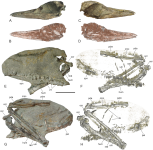Fred Ruhe
Well-known member

Gerald Mayr, Vanesa L. De Pietri, Leigh Love, Al Mannering, Erica Crouch, Catherine Reid, and R. Paul Scofield, 2023
Partial skeleton from the Paleocene of New Zealand illuminates the early evolutionary history of the Phaethontiformes (tropicbirds)
ALCHERINGA: AN AUSTRALASIAN JOURNAL OF PALAEONTOLOGY
Abstract and free pdf: https://www.tandfonline.com/doi/ful...3.2246528?scroll=top&needAccess=true&role=tab
We describe a new stem group representative of the Phaethontiformes (tropicbirds) from the Paleocene Waipara Greensand in New Zealand. The fossil consists of a partial skeleton with a nearly complete skull and represents the first unambiguous record of the Phaethontiformes from the Paleocene of the Southern Hemisphere. Clymenoptilon novaezealandicum gen. et sp. nov. has a proportionally shorter pelvis than Prophaethon shrubsolei from the early Eocene London Clay and appears to have been less adapted to foraging in an aquatic environment at or below sea-level. It is furthermore distinguished from P. shrubsolei and Lithoptila abdounensis from the late Paleocene/early Eocene of Morocco in a proportionally smaller foramen magnum of the skull. Together with other plesiomorphic features, this suggests that C. novaezealandicum is the sister taxon of a clade including Lithoptila, Prophaethon and crown group Phaethontiformes, and as one of the oldest stem group phaethontiforms the new species may indicate a Southern Hemispheric centre of origin of tropicbirds. After a recently described bony-toothed bird, C. novaezealandicum is the second seabird species from the Waipara Greensand to show affinities to taxa from the early Paleogene of the Northern Hemisphere. The wide early Paleogene distribution of the Phaethontiformes stands in sharp contrast to the geographic restriction of coeval diving seabirds, and different factors appear to have limited the dispersal of aquatic and pelagic seabird taxa in the early Paleogene.
Enjoy,
Fred
Partial skeleton from the Paleocene of New Zealand illuminates the early evolutionary history of the Phaethontiformes (tropicbirds)
ALCHERINGA: AN AUSTRALASIAN JOURNAL OF PALAEONTOLOGY
Abstract and free pdf: https://www.tandfonline.com/doi/ful...3.2246528?scroll=top&needAccess=true&role=tab
We describe a new stem group representative of the Phaethontiformes (tropicbirds) from the Paleocene Waipara Greensand in New Zealand. The fossil consists of a partial skeleton with a nearly complete skull and represents the first unambiguous record of the Phaethontiformes from the Paleocene of the Southern Hemisphere. Clymenoptilon novaezealandicum gen. et sp. nov. has a proportionally shorter pelvis than Prophaethon shrubsolei from the early Eocene London Clay and appears to have been less adapted to foraging in an aquatic environment at or below sea-level. It is furthermore distinguished from P. shrubsolei and Lithoptila abdounensis from the late Paleocene/early Eocene of Morocco in a proportionally smaller foramen magnum of the skull. Together with other plesiomorphic features, this suggests that C. novaezealandicum is the sister taxon of a clade including Lithoptila, Prophaethon and crown group Phaethontiformes, and as one of the oldest stem group phaethontiforms the new species may indicate a Southern Hemispheric centre of origin of tropicbirds. After a recently described bony-toothed bird, C. novaezealandicum is the second seabird species from the Waipara Greensand to show affinities to taxa from the early Paleogene of the Northern Hemisphere. The wide early Paleogene distribution of the Phaethontiformes stands in sharp contrast to the geographic restriction of coeval diving seabirds, and different factors appear to have limited the dispersal of aquatic and pelagic seabird taxa in the early Paleogene.
Enjoy,
Fred




